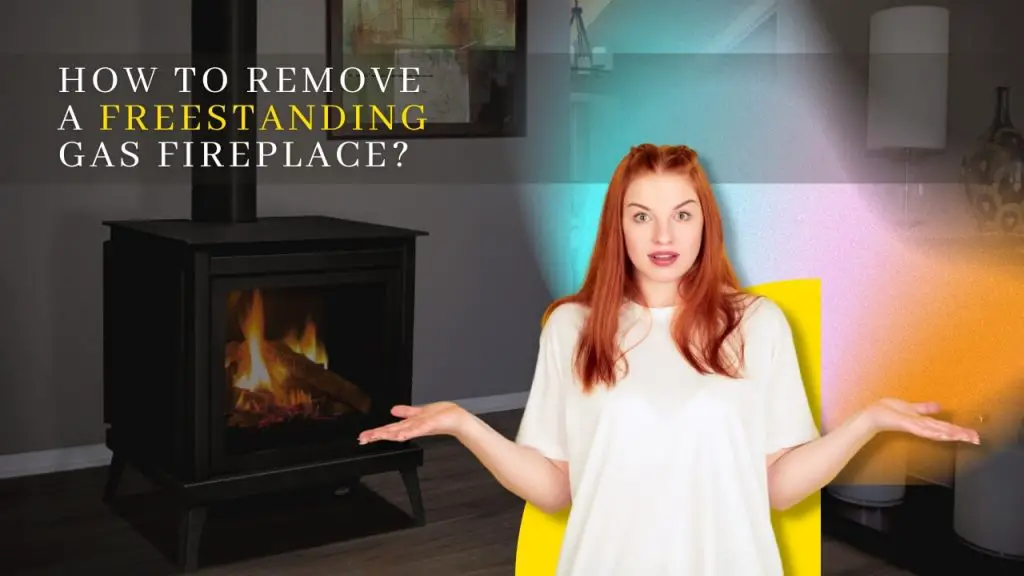When winter comes, everyone scampers around to get as much heating as they can in their homes. While a central heating system is a popular and effective option, the energy bills it attracts can drive you crazy.
To save cost and still get adequate heating, options like a freestanding gas fireplace are gaining popularity among homeowners for their energy-efficient and low-maintenance design.
Once installed, you can use a freestanding gas fireplace for many years, but what happens when you need to move it? How do you remove a freestanding gas fireplace?
DIY – How to Remove a Freestanding Gas Fireplace?
For whatever- whether you want to convert the energy source from gas to wood, move it to a different spot or remove it from your home altogether, removing a freestanding gas fireplace is a very serious DIY.
Depending on how the gas fireplace was installed or built, removing it can be a pretty technical process that requires piping and electrical works. In most cases, we advise you have a plumber, gas engineer and electrician take a look before you touch anything.
In fact, if the fireplace has gas pipes and electrical supplies that require disconnection, you should get a plumber and an electrician to have them disconnected.
However, if you’re quite the handyman, you may decide take on the task yourself, but you must be extra careful. We’ve put together a comprehensive guide to help you through the entire process.
Required Materials
- A couple of adjustable or open-end wrenches for loosening any fitting.
- Yellow Teflon tape
- Gas pipe cap, preferably black.
- Hand gloves.
- Gas mask or any available mask to protect you from gas poisoning.
You must also ensure there’s no fire or flame close by. Some people will also suggest you have a fire extinguisher close by, but that is unlikely to be any help if a gas explosion does occur. It is important to repeat at this point that this is a truly risky DIY.
Step by Step Process
1. Remove the trim
You’ll find this around the edge of the firebox if there is any. By removing it, you’ll create more room for the task ahead.
If there’s a fireplace surround, you should also remove it next. Again, this is one way of removing obstructions or obstacles before you begin the air business.
2. Disconnect fireplace from gas line
Oftentimes, you’ll find a cutoff valve attached to the gas line, not more than 6 feet away. While this may be enough, it is better to also cut off the supply to this line entirely.
To do this, you should find a larger valve further away from the fireplace and probably closer to the gas source. If the line supplies gas to other appliances, be sure to terminate it at the juncture before the multiple outlets.
3. Disconnect the gas line
Once you’re sure there’s no supply to the gas fireplace, go ahead and disconnect the line from the appliance. Use the approved Yellow Teflon Tape like the Vanguard Sealant Tape to wrap the edge of the pipe, then cap it with a gas pipe cap.
4. Check for leaks
To be sure there are no leaks, fill a spray bottle with a mixture of water and dishwashing soap. Turn the gas back on, then spray the mixture on all connections that you tampered with.
If there are no bubbles, it means you’ve done the right thing. If you do find bubbles, it means there’s a leak. Turn the gas off and repeat the process or call in a professional.
5. Remove vent apparatus
Most freestanding gas fireplaces are connected to the home’s chimney for venting or have a separate venting outlet on the roof or wall.
You’d need to disconnect the venting apparatus that connects the fireplace to the roof or wall at this point. A wrench may be useful here. This is not necessary where it is a B-vent fireplace that uses the chimney. These do not have vents that require disconnecting.
6. Disconnect electrical supply
You should get an electrician to do this, except you’re really skilled in electrical installations. Also, if it is simply a plug, you can easily disconnect it. Just be sure you’re not leaving any naked wires exposed on the floor or hanging from the roof.
7. Remove all cable fixings
Remove all cable fixings that may be holding the unit against the wall.
8. Remove the fireplace
This is the final step, you just need to remove the fireplace.
Precautions
As we stated earlier, it is best to call in the professionals, especially if it is powered by propane or natural gas and requires pipe disconnections, as well as electrical disconnections.
Also, some cities may legally require that you call a professional if you need to remove a gas fireplace. If you insist you have to do it yourself in cities where you’re allowed to, here are a few precautions to note;
- Ensure there’s no fire burning anywhere.
- Shut off gas supply on the gas line.
- Also disconnect electrical supply to the unit.
- Be sure there are no gas leaks anywhere.
- Avoid friction between metals, as much as possible.
How Much Does It Cost to Remove Freestanding Gas Fireplace Through DIY?
To remove a freestanding gas fireplace by yourself, all you may require are the tools already listed above.
Adjustable or open-end wrenches for loosening any fitting, Yellow Teflon tape, Gas pipe cap, hand gloves, and a gas mask or any available mask to protect you from gas poisoning.
Altogether, these items will not cost more than $50 or $70.
The DIY approach certainly cuts out the fees that professionals will normally charge for fireplace removal. Although cheaper, it is the more risky option.
Note that the cost above does not include the removal of chimney fireplaces or wall-mounted fireplaces.
Here, the cost tremendously goes up as a result of demolition, installation of structural support and repairs you may need to carry out on the walls, the floor and the roof (in many cases). When you put all of that together, the cost may rise to as much as $3,500.
How Much Does It Cost to Remove Freestanding Gas Fireplace by Hiring a Professional?
Removing a freestanding gas fireplace can take several hours as a result of the sensitive processes involved.
If you do call in a professional, a partial removal may cost between $300 and $1,500.
This is also likely the case for the full removal of a freestanding fireplace. However, if you intend to do a full removal on a load-bearing brick wall, there are several structural repairs that will follow, which will cost an average of $5,000. This includes materials for fixing damages on the walls, floor and roof, as well as professional fees.
It is important to state that this cost also varies based on what you may want the professionals to do to your wall after the fireplace removal.
Final Words:
While freestanding gas fireplaces are an important heating appliance, home remodeling and upgrade may force us to move them to a different spot or take them out altogether.
This removal process is a big deal for many people, wondering if they can simply put on their DIY gloves and get to work or call in the professional.
Although the cost-effectiveness of a DIY is attractive, it is best to call a professional. If you’re convinced you can handle it, this post is a simple guide to show you everything you need to know about freestanding gas fireplace removal.
| Photo | Title | Buy |
|---|---|---|

|
LEVOIT Air Purifier for Home & Bedroom - For Allergies and Pets Hair | Check Price On Amazon |

|
BREEZOME 60 OZ Quiet Dehumidifiers for Home, Dual-Semiconductor | Check Price On Amazon |

|
AquaOasis™ Cool Mist Quiet Ultrasonic Humidifier for Bedroom & Large room | Check Price On Amazon |

|
43.3'' Portable Air Conditioners, 3-IN-1 Evaporative Air Cooler w/Remote | Check Price On Amazon |

|
BlueDri BD-AS-550-BL Negative Machine Airbourne Cleaner HEPA Air Scrubber | Check Price On Amazon |

|
Space Heater, VCK 24" 12ft/s Fast Quiet Heating Portable Electric Heater | Check Price On Amazon |








